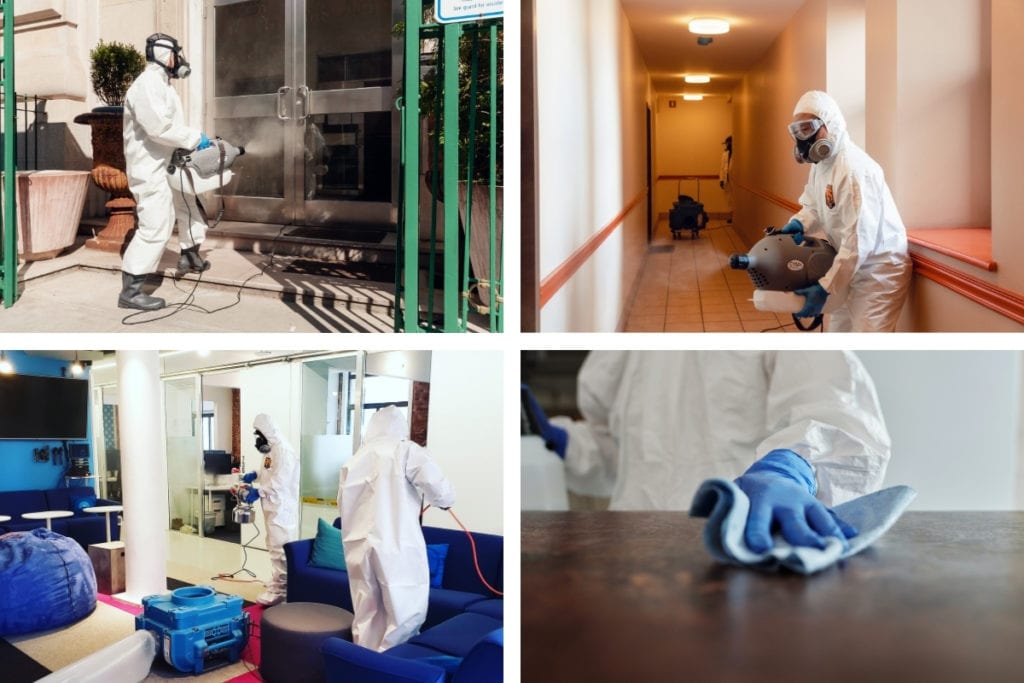Using Electrostatic Fogging & Spraying to Disinfect Coronavirus
If you’re researching ways to disinfect your workplace, home, or business, then you’ve probably heard of the terms “electrostatic spraying” or “electrostatic fogging”.
Due to the coronavirus pandemic, an increasing number of companies now offer sanitizing services utilizing electrostatic technology. Electrostatic fogging and spraying services are designed to disinfect and decontaminate large indoor spaces in a relatively short amount of time. This helps eliminate pathogens like the coronavirus (SARS-CoV-2) from homes, schools, businesses, and more.
In this article, we’ll explain how electrostatic fogging & spraying technology works, as well as the official guidance and recommendations around using electrostatic fogging for COVID-19 disinfection.
What is Electrostatic Disinfection?
Electrostatic technology uses interactions between charged particles to quickly and efficiently apply a disinfectant solution across a large surface area.
Electrostatic fogging and spraying machines, which vary in size and power, generate a fine mist of charged droplets containing the disinfectant solution. The electrostatic charge causes the disinfectant droplets to be attracted to surfaces and objects, coating them from all directions and killing pathogens like the coronavirus.
The benefits of electrostatic disinfection methods include improved, 360-degree coverage across large surface areas and significantly reducing the risk of exposure to the virus. Unlike regular cleaning and wiping, there is also no risk of cross-contaminating surfaces when using electrostatic fogging and spraying. Electrostatic fogging, in particular, can be used to safely sanitize sensitive surfaces like paper and electronics without soaking or damaging them.
How does Electrostatic Disinfection work?
- An EPA-registered liquid disinfectant solution from List N (effective against the coronavirus SARS-CoV-2) is added to a special fogging or spraying machine.
- An electrode in the nozzle adds a positive electrostatic charge to the solution. The nozzle also pressurizes and atomizes the liquid, expelling a fine mist of microscopic, positively-charged droplets (approximately 10 microns in diameter).
- The positively-charged droplets repel one another in the air, which helps the disinfectant solution quickly disperse across a large area.
- Most surfaces have a slight negative charge, causing the positive disinfectant droplets to become attracted to and wrap around these surfaces.
- As a thin layer of disinfectant begins to settle, the positively-charged solution repels other droplets in the air, resulting in a uniform layer that covers all surfaces and objects evenly. In addition to maximizing the surface area covered with minimal waste, this electrostatic effect also prevents the liquid from saturating and damaging sensitive surfaces like paper and electronics.
- Within a few minutes of dwell time, the disinfection solution inactivates and kills any live viruses present.
- Subsequently wiping surfaces removes the inactivated virus, and air scrubbers are used to filter out excess airborne particles.

Is there a difference between Electrostatic Fogging and Electrostatic Spraying?
Electrostatic technology can be applied to both fogging and spraying. The terms “electrostatic fogging” and “electrostatic spraying” are sometimes used interchangeably, although there are key differences between the two methods.
- Electrostatic fogging is typically used to rapidly disinfect a large area. By dispersing a fine mist of aerosolized disinfectant droplets into the air, the disinfectant solution settles evenly across many surfaces at once.
- Electrostatic spraying usually describes a more targeted approach that ejects the disinfectant solution directly at a specific surface or object.
- Another key difference is the size of the disinfectant droplets. Foggers create atomized disinfectant droplets around 10 microns in diameter, which are much smaller compared to the average droplet size of electrostatic sprayers (around 200 microns).
- The smaller droplet size allows the disinfectant solution to remain suspended in the air longer and bond to airborne particles. The microscopic droplets can also safely disinfect sensitive surfaces like paper and electronics without soaking or damaging them.
Is Electrostatic Fogging Safe?
Before the coronavirus pandemic, electrostatic spraying and fogging technologies were already commonly used in the medical, food, and airline industries to sanitize large spaces with high standards of safety and efficiency. They have also been proven effective at disinfecting surfaces from SARS-CoV-2 when applied properly by trained professionals wearing appropriate protective equipment.
Electrostatic spraying and fogging are recommended by the CDC and EPA to disinfect large indoor spaces and public areas only when used with certain disinfectant products that specifically include electrostatic spraying and fogging in their product label instructions.
Proper application of electrostatic spraying and fogging also requires surfaces to be cleaned and clear of dust and debris. After the application is finished, the disinfectant solution must be left on surfaces for a certain period of time before wiping and drying. The required contact time, or dwell time, can be in the product label instructions.
Professional Coronavirus (SARS-CoV-2) Disinfection Services
Looking for electrostatic fogging or spraying services to properly disinfect a home, office, building, or business?
Green Orchard Group provides customizable disinfecting and sanitizing services based on your needs, including electrostatic fogging, air exchanging, and careful manual wipedowns with long-lasting, EPA-approved disinfectants. If someone you know has tested positive for COVID-19, our HAZWOPER-certified technicians are available 24/7 for emergency decontamination.
Green Orchard Group is a leader in environmental health services and coronavirus disinfection services based in New York City and the Tri-State Area. Our knowledgeable and experienced professionals hold training and certifications from the EPA, Occupational Safety and Health Administration (OSHA), Institute of Inspection, Cleaning, and Restoration (IICRC), American Industrial Hygiene Association (AIHA), and more. We have been trusted by hundreds of businesses, schools, hospitals, and property owners to safely and reliably disinfect their premises of pathogens and biohazards.
Call (212)219-8261 or contact us for a free consultation and quote today!


